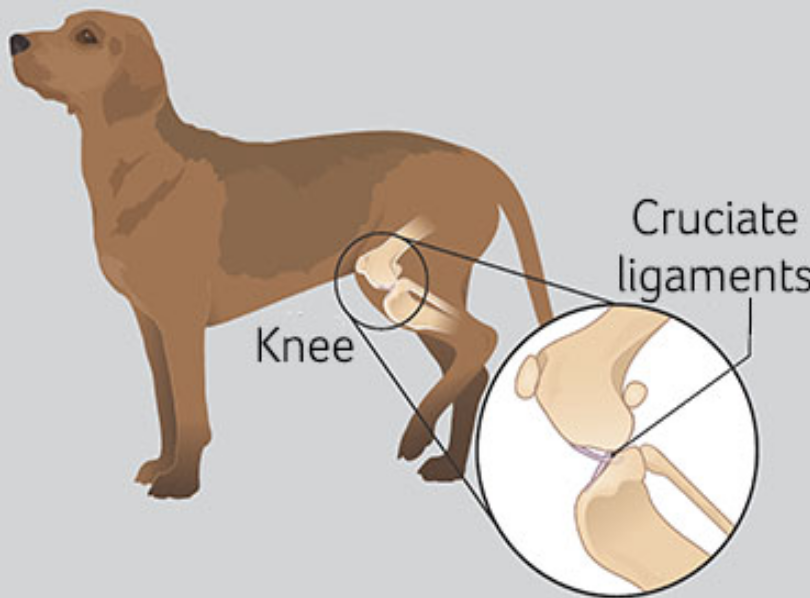
What are some of the causes of a limping dog? If your dog suddenly started limping on one of its back legs, it could be different reasons. One of the most common causes of lameness is a ruptured cruciate ligament.
What Is a Cruciate Ligament Injury?
There are two cruciate ligaments in a dog’s knee joint. The ligaments connect the femur (thigh bone) to the tibia (shin bone). This stabilizes the knee joint. The ligament can rupture completely or partially. The complete tear is also called an ACL or CCL tear. A ruptured cruciate is painful and immobilizing. While not life-threatening, it must be addressed.
Signs of a Cruciate Ligament Injury in Dogs
When the cruciate ligament tears, the tibia moves freely from under the femur, causing pain and lameness. Sudden lameness in a rear leg is often the first sign of injury.1 The lameness can worsen with activity and improve with rest. If an injury remains unaddressed, arthritic changes occur quickly. This leads to chronic lameness and discomfort. If your dog suddenly shows signs of pain or limping, take it to your vet as soon as possible.
Causes of a Cruciate Ligament Injury
The two leading causes of cruciate ligament rupture in dogs are degeneration of the ligament and trauma. A tear can result from an athletic injury in a healthy dog. This could even mean landing “wrong” when running or jumping. Overweight or obese dogs are more prone to this type of injury, as they carry more weight and are prone to ligament degeneration.
Additionally, some dog breeds/types are predisposed to cruciate ligament injuries. Including Rottweilers, Labrador retrievers, Newfoundlands, and Staffordshire terriers.
Treatment and Prevention
Medical management, consisting of physical therapy and weight control. Is variably successful in getting your dog to return to normal activities. Smaller dogs (< 25-30 pounds) fair better than heavier dogs. These dogs will develop osteoarthritis in the affected knee joint.
Medical therapy involves several weeks of:
- cage rest,
- With brief, calm leash walks for bathroom breaks only,
- Sit-to-stand exercises, underwater treadmill therapy and/or swimming.
- Affected dogs also chronically receive veterinary-approved oral anti-inflammatory drugs and supplements to support joint health.
Although rest and medication may help, surgery is usually recommended to repair the ruptured cruciate ligament.
In general, the prognosis after surgery is good, with an 85%-90% chance of a return to the average activity level. There are several different surgical approaches, each with its pros and cons.
A cruciate rupture cannot always be prevented. But, keeping your dog at a healthy weight and providing plenty of exercises can minimize the risk.
If your dog has a cruciate injury, talk to your vet about getting a referral to a board-certified veterinary surgeon. There, you can discuss the best option for your dog and your lifestyle.
Cruciate Surgery: Extracapsular Repair
In this method, a strong suture is placed. To secure the femur and tibia, essentially replacing the function of the torn cruciate ligament. The suture supports the knee joint. While scar tissue builds up and the muscles surrounding the knee strengthen.
The suture invariably loosens or breaks at some point. It must stay intact for eight to 12 weeks for healing to occur.
This is a relatively quick and uncomplicated procedure with reasonable success rates, significantly smaller dogs. It is less expensive than other methods. Long-term success varies and may be better for smaller dogs.
Cruciate Surgery: TPLO
Another surgical option is the “Tibial Plateau Levelling Osteotomy” (TPLO). This is a more complex procedure than the extracapsular method. And requires specific surgical equipment and training.
The TPLO alters the biomechanics of the knee joint. Which allow it to function correctly without a cruciate ligament. The cut is through the top of the tibia (the tibial plateau). The tibial plateau is changing the angle of this portion of the bone. A metal plate is affixed to repair the cut bone. The tibia heals over several months.
Partial improvement will appear within days. However, full recovery will take several months, so cage rest is essential. Generally, the long-term prognosis is good, and re-injury is uncommon. Unless problems occur, the plate is not removed.
As with any surgery, complications are possible, including infection. The TPLO is significantly more expensive than traditional surgery.
Cruciate Surgery: TTA
A third surgical method is the tibial tuberosity advancement (TTA). The details of this method are slightly different from a TPLO, but the TTA still involves cutting the tibia and placement of metal implants.
Some surgeons describe the TTA as a less invasive procedure than the TPLO and faster recovery, while other surgeons see little difference. The dog’s anatomy and lifestyle are also deciding factors. The cost of the TTA is comparable to the TPLO.
Cruciate Surgery Recovery in Dogs
Regardless of the type of surgery, strict activity rest for at least eight weeks after surgery is crucial for healing. Physical therapy is helpful for long-term recovery.
Following your vet’s recommendations will give your dog the best chance of full recovery with fewer complications. As with any orthopaedic surgery, it is common for dogs to develop arthritis in the future. With proper care, your dog can live a full, healthy, and comfortable life. Dogs have a 40 to 50 per cent chance of tearing the ligament in their other knee.
